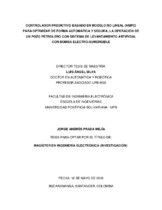| dc.contributor.advisor | Director. Silva, Luis Ángel | |
| dc.contributor.author | Prada Mejía, Jorge Andrés | |
| dc.coverage.temporal | 2018 | |
| dc.date.accessioned | 2020-06-04T16:05:56Z | |
| dc.date.available | 2020-06-04T16:05:56Z | |
| dc.date.issued | 2018 | |
| dc.identifier.uri | http://hdl.handle.net/20.500.11912/5539 | |
| dc.description | 122p.: (pdf); il; gráficas; tablas. | spa |
| dc.description.abstract | Esta Tesis presenta una estrategia de control avanzado para la optimización de la operación del sistema de levantamiento artificial (SLA) con bombeo electro-sumergible (BES) en un pozo productor petrolero. La estrategia corresponde a un controlador predictivo basado en modelo no lineal (NMPC) que ajusta la frecuencia de operación de la bomba de forma automática y segura, logrando controlar la producción del pozo, teniendo en cuenta restricciones específicas sobre el sistema y considerando el comportamiento actual y futuro de éste. La metodología propuesta comprende la selección de la estructura e identificación paramétrica del modelo del sistema denominado yacimiento—pozo-SLA, el diseño y desarrollo del controlador NMPC, la sintonización y pruebas de desempeño en ambiente de simulación para un pozo productor de un campo de producción Colombiano. Se muestran resultados del desempeño del sistema de control NMPC en ambiente de simulación y se compara con una estrategia de control compuesta por una optimización en estado estable y un controlador PI (SSO+PI). Los resultados evidencian un mejor desempeño del controlador NMPC debido a la no violación de las restricciones a pesar de las perturbaciones del sistema, mientras que el SSO+PI sobrepasó algunos de los límites violando restricciones, lo que conlleva a descartar esta última opción como una solución viable para el control de un pozo productor de hidrocarburos por poner en riesgo la seguridad de la operación. Se muestra la superioridad del controlador NMPC por su capacidad para mitigar efectos de la incertidumbre del modelo predictivo, por realizar una optimización dinámica en línea en contraste con la optimización de estado estable fuera de línea en un punto inicial realizada por el SSO+PI, y por su capacidad de ajustar límites en la razón de cambio de la variable manipulada, permitiendo cumplir requerimientos de campo relacionados con el máximo torque permitido en la operación de la bomba electro-sumergible. | spa |
| dc.description.abstract | This masterl's thesis presents an advanced control strategy for the optimization of the operation of the artificial lift system (SLA) with electro-submersible pumping (BES) in a hydrocarbon producing well. The strategy corresponds to a predictive controller based on a non-linear model (NMPC) that adjusts the operating frequency of the electro-submersible pump automatically and safely, managing to control the production flow of the well, taking into account specific restrictions on the system and considering its current and future behavior. The proposed methodology includes the selection of the structure and parametric identification of the model of the system called reservoir - producer well - SLA BES, the design and development of the NMPC controller, the tuning and performance tests in a simulation environment for a hydrocarbon producing well. a Colombian production field. The performance results of the NMPC control system in the simulation environment are shown and compared with a control strategy composed of a stable state optimization and a PI controller (SSO + PI). The results show a better performance of the NMPC controller due to the non-violation of the restrictions despite the system disturbances, while the SSO + PI exceeded some of the limits violating restrictions, which leads to discarding the latter option as a solution viable for the control of a well producing hydrocarbons for putting at risk the safety of the operation. The superiority of the NMPC controller is shown by its ability to mitigate the effects of the uncertainty of the predictive model, by performing a dynamic online optimization in contrast to the off-line stable state optimization at an initial point made by the SSO + PI, and for its ability to adjust limits on the change rate of the manipulated variable, allowing compliance with field requirements related to the maximum torque allowed in the operation of the electro-submersible pump. | eng |
| dc.format.mimetype | application/pdf | |
| dc.language.iso | spa | |
| dc.publisher | Universidad Pontificia Bolivariana | spa |
| dc.rights | Attribution-NonCommercial-NoDerivatives 4.0 International | * |
| dc.rights.uri | http://creativecommons.org/licenses/by-nc-nd/4.0/ | * |
| dc.title | Controlador predictivo basado en modelo no lineal (nmpc) para optimizar de forma automática y segura, la operación de un pozo petrolero con sistema de levantamiento artificial con bomba electro-sumergible | spa |
| dc.type | Tesis de Maestría | spa |
| dc.publisher.department | Escuela de Ingenierías | spa |
| dc.publisher.program | Maestría en Electrónica | spa |
| dc.type.hasVersion | publishedVersion | spa |
| dc.description.sectional | Bucaramanga | spa |
| dc.description.degreename | Magíster en Electrónica | spa |


